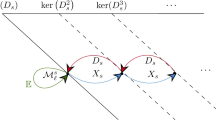Abstract
There has recently been evidence for replacing the usual Weyl quantization procedure by the older and much less known Born–Jordan rule. In this paper we discuss this quantization procedure in detail and relate it to recent results of Boggiato, De Donno, and Oliaro on the Cohen class. We begin with a discussion of some properties of Shubin’s τ-pseudo-differential calculus, which allows us to show that the Born–Jordan quantization of a symbol a is the average for \({\tau\in[0,1]}\) of the τ-operators with symbol a. We study the properties of the Born–Jordan operators, including their symplectic covariance, and give their Weyl symbol.
Similar content being viewed by others
References
Boggiatto P., De Donno G., Oliaro A.: Time–frequency representations of Wigner type and pseudo-differential operators. Trans. Am. Math. Soc. 362(9), 4955–4981 (2010)
Boggiatto P., Cuong B.K., De Donno G., Oliaro A.: Weighted integrals of Wigner representations. J. Pseudo-Differen. Oper. Appl. 1(4), 401–415 (2010)
Born M., Jordan P.: Zur Quantenmechanik. Zeits. Physik 34, 858–888 (1925)
Castellani L.: Quantization rules and Dirac’s correspondence. Il Nuovo Cimento 48A(3), 359–368 (1978)
Crehan P.: The parametrisation of quantisation rules equivalent to operator orderings, and the effect of different rules on the physical spectrum. J. Phys. A Math. Gen. 22(7), 811–822 (1989)
Fedak W.A., Prentis J.J.: The 1925 Born and Jordan paper “On quantum mechanics”. Am. J. Phys. 77(2), 128–139 (2009)
de Gosson, M.: Symplectic Geometry and Quantum Mechanics, Birkhäuser, Basel, series “Operator Theory: Advances and Applications” (subseries: “Advances in Partial Differential Equations”), vol. 166 (2006)
de Gosson, M.: Symplectic methods in harmonic analysis. Appl. Math. Phys., Birkhäuser (2011, to appear)
de Gosson, M., Hiley, B.: Imprints of the quantum world in classical mechanics. Preprint (2010)
Gröchenig K.: Foundations of Time–Frequency Analysis. Birkhäuser, Boston (2000)
Kauffmann, S.K.: Unambiguous quantization from the maximum classical correspondence that is self-consistent: the slightly stronger canonical commutation rule Dirac missed. arXiv:0908.3024 (2010)
Mackey, G.W.: The relationship between classical and quantum mechanics. In: Contemporary Mathematics 214, Amer. Math. Soc., Providence, RI (1998)
Molahajloo S.: The heat kernel of the τ-twisted Laplacian. J. Pseudo-Differen. Oper. Appl. 1(3), 293–311 (2010)
Shubin, M.A.: Pseudodifferential Operators and Spectral Theory. Springer, Berlin (1987) [original Russian edition in Nauka, Moskva (1978)]
Weyl H.: Quantenmechanik und Gruppentheorie. Zeitschrift für Physik 46, 1–46 (1927)
Wong M.W.: Weyl Transforms. Springer, Berlin (1998)
Author information
Authors and Affiliations
Corresponding author
Additional information
M. de Gosson was financed by the Austrian Research Agency FWF (Projektnummer P20442-N13).
F. Luef was financed by the Marie Curie Outgoing Fellowship PIOF 220464.
Rights and permissions
About this article
Cite this article
de Gosson, M., Luef, F. Preferred quantization rules: Born–Jordan versus Weyl. The pseudo-differential point of view. J. Pseudo-Differ. Oper. Appl. 2, 115–139 (2011). https://doi.org/10.1007/s11868-011-0025-6
Received:
Revised:
Accepted:
Published:
Issue Date:
DOI: https://doi.org/10.1007/s11868-011-0025-6



